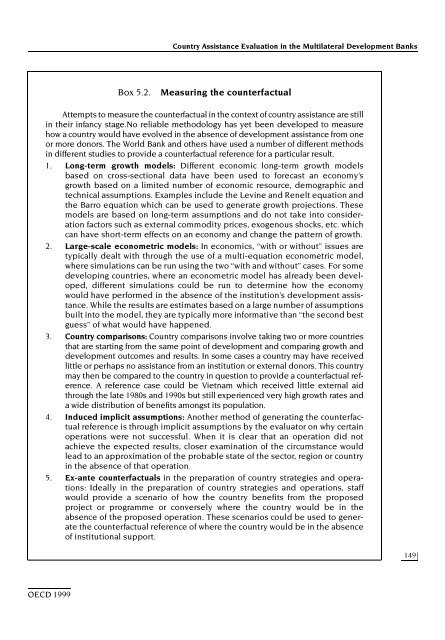Evaluating Country Programmes - OECD Online Bookshop
Evaluating Country Programmes - OECD Online Bookshop
Evaluating Country Programmes - OECD Online Bookshop
Create successful ePaper yourself
Turn your PDF publications into a flip-book with our unique Google optimized e-Paper software.
<strong>OECD</strong> 1999<br />
<strong>Country</strong> Assistance Evaluation in the Multilateral Development Banks<br />
Box 5.2. Measuring the counterfactual<br />
Attempts to measure the counterfactual in the context of country assistance are still<br />
in their infancy stage.No reliable methodology has yet been developed to measure<br />
how a country would have evolved in the absence of development assistance from one<br />
or more donors. The World Bank and others have used a number of different methods<br />
in different studies to provide a counterfactual reference for a particular result.<br />
1. Long-term growth models: Different economic long-term growth models<br />
based on cross-sectional data have been used to forecast an economy’s<br />
growth based on a limited number of economic resource, demographic and<br />
technical assumptions. Examples include the Levine and Renelt equation and<br />
the Barro equation which can be used to generate growth projections. These<br />
models are based on long-term assumptions and do not take into consideration<br />
factors such as external commodity prices, exogenous shocks, etc. which<br />
can have short-term effects on an economy and change the pattern of growth.<br />
2. Large-scale econometric models: In economics, “with or without” issues are<br />
typically dealt with through the use of a multi-equation econometric model,<br />
where simulations can be run using the two “with and without” cases. For some<br />
developing countries, where an econometric model has already been developed,<br />
different simulations could be run to determine how the economy<br />
would have performed in the absence of the institution’s development assistance.<br />
While the results are estimates based on a large number of assumptions<br />
built into the model, they are typically more informative than “the second best<br />
guess” of what would have happened.<br />
3. <strong>Country</strong> comparisons: <strong>Country</strong> comparisons involve taking two or more countries<br />
that are starting from the same point of development and comparing growth and<br />
development outcomes and results. In some cases a country may have received<br />
little or perhaps no assistance from an institution or external donors. This country<br />
may then be compared to the country in question to provide a counterfactual reference.<br />
A reference case could be Vietnam which received little external aid<br />
through the late 1980s and 1990s but still experienced very high growth rates and<br />
a wide distribution of benefits amongst its population.<br />
4. Induced implicit assumptions: Another method of generating the counterfactual<br />
reference is through implicit assumptions by the evaluator on why certain<br />
operations were not successful. When it is clear that an operation did not<br />
achieve the expected results, closer examination of the circumstance would<br />
lead to an approximation of the probable state of the sector, region or country<br />
in the absence of that operation.<br />
5. Ex-ante counterfactuals in the preparation of country strategies and operations:<br />
Ideally in the preparation of country strategies and operations, staff<br />
would provide a scenario of how the country benefits from the proposed<br />
project or programme or conversely where the country would be in the<br />
absence of the proposed operation. These scenarios could be used to generate<br />
the counterfactual reference of where the country would be in the absence<br />
of institutional support.<br />
149

















![CQE=U]^\]Z: KAZAKHSTAN - OECD Online Bookshop](https://img.yumpu.com/3915768/1/190x253/cqeuz-kazakhstan-oecd-online-bookshop.jpg?quality=85)